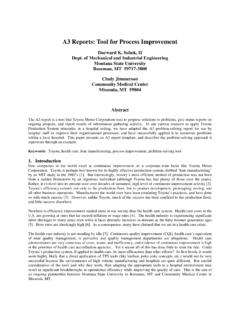Transcription of Lean Problem Solving Zele 1107
1 Author: Dirk DenutAuthor: Dirk DenutDate: month / 2011 Problem SolvingContent What do we know already? Introduction Benefits & goal Types 8 Step Problem Solving process Why? When? How? Quiz Time What do we know already?IntroductionBenefits of Structured Problem Solving process Remove time lostin debate Identify weakpoints in processes Discover systemiccauses Explain with reasons whyan incident occurred Gives a factualrepresentation of the incident Compare what actuallyhappened against what shouldhave happened, at any point during the , at any point during the Problem Solving to of Problem Solving methodsDMAICDMAIC8 Step Problem Solving data driven toolLast 3 Steps Deploy SolutionFirst 5 StepsDeploy SolutionShare KnowledgeCreate StandardsSolve theActual Problem8 Step Problem Solving ProcessWhy use this process approach?
2 Process has proven its usefullness in other companies Common methodology everybody understands how Focus on Fixing it - first time right Define priorities Sharing the lessons learned with othersWhen do we use the 8 Step Process? Significant or repetitive complaints Repetitive human errors occurring during a specific process Repetitive equipment failures associated with a specific Repetitive equipment failures associated with a specific process Performance is generally below desired standard ..Major impact or Repetitive issuesHow to solve problems? The Problem Solving process is based upon PlanDoICONS? Do Check ActProblem Solving GuideHow does the process in more detail look like?8 Step process -Sustain the gainDevelop CountermeasuresDetermine Root process -Sustain the gainClarify the ProblemConfirm Results & ProcessSee Countermeasures throughBreak down the problemTarget SettingFit detail with PDCA?
3 The ProblemWhy?How?What? down the root countermeasuresPHow? countermeasures results & process Sustain the gainDCAP roblem Solving GuideProblem Solving GuideStep 1: Clarify the ProblemStep 1:Clarify the ProblemDesired / Ideal Desired / Ideal SituationSituationGap = ProblemGap = ProblemVisualizationCurrent SituationCurrent SituationVisualization(Make Explicit) We need to understand the Current Situation (Measured), Ideal Situation (Standard) Why is it a Problem ? What is the KPI affected? What is the cost? Relation to Objective? Why is it a priority?Step 1:Clarify the Problem Anything that deviates from the standard or targetWhat is a Problem ?Step 1:Clarify the ProblemWhat is a Problem ?
4 ContStep 1:Clarify the Problem An unfulfilled customer s needWhat is a Problem ?..contStep 1:Clarify the Problem Problem type - IStep 1:Clarify the Problem The new higher standard is targetProblem type IIThe new higher standard is targetStep 1:Clarify the Problem Problem type IIIP roblem Solving GuideStep 2: Break Down the ProblemStep 2 : Break Down the ProblemProblemProblemProblemProblem (complex vague)Break downBreak downWhat . Where . When . WhoWhat . Where . When . WhoWhyWhySee the ProcessPoint ofCauseProblemProblemProblemProblemProbl emProblemProblemProblem to tackleWhat . Where . When . WhoWhat . Where . When . WhoWhyWhyPrioritize the problemPrioritizedProblemPrioritize the problemStep 2 : Break Down the Problem Requires to study the process to detail Dedicate sufficient time for the breakdown Study the steps of the process, interact with people, get data, documents, understand tools: Learn All problems can be divided into smaller defined problems: by region, location, department, product, All problems can be divided into smaller defined problems: by region, location, department, product, channel, customers, etc.
5 Specify the point of cause: the Problem is present in a specific part of the processStep 2 : Break Down the Problem Step 2 : Break Down the Problemscratches discoveredscratches presentNo scratchesscratches presentscratches presentscratches present Specify the Point of Cause by Studying the Process Specify the Point of Cause is necessary for Effective Root Cause AnalysisProblem PerceptionPoint of CauseTrace backTrace backTrace backTrace backTrace backProblem Solving GuideStep 3: Target SettingStep 3 : Target SettingSMARTWhat?How much?By when?Output / DeliverableTo Be AchievedNOT things to DOTargets are a tool to stimulate improvementStep 3 : Target SettingGOODor BAD We will improve the way we handle complaints We will reduce the number of complaints by 10% by next BB We will reduce the number of complaints by 10% by next FY We will increase our CPE score from 75% to 85% in next FY by end of Q3 We will increase our sales next FYGBBP roblem Solving GuideStep 4: Determine the Root CauseStep 4 : Determine Root CauseWhy Root Cause Analysis?
6 To solve problems on structural basis To ensure problems do not return To ensure problems do not return To ensure sustainable improvements are madeStep 4 : Determine Root Cause Fact Gathering & AnalysisObserved SymptomsContainment actionMore Detailed AnalysisDIRECT CausesROOT CausesCorrective actionPreventive actionTools used in Problem SolvingMulti disciplinary TeamworkPareto analysis (80/20)BrainstormingControl ChartTools used in Problem Solving No judgment or criticism Quantity over quality Quality implies judgment Freewheel Do not get trapped by your own train of thinking Mutate and combine Keep using previous ideas as stimuli for new ideas Visualization of measurements Upper & lower specification limits + mean Location of measurements helps analysisTools used in Problem Solving Recording manually Mark per topic, number of occurrence Visualization can be done via Histogram Visualization can be done via Histogram (distribution), Pareto (counts)
7 , locationLocation checksheetTools used in Problem SolvingUniversal principle, called the "vital few and trivial many Pareto's Principle or the 80/20 Rule - 20 percent of something always are responsible for 80 percent of the results100%80%20%20% of the input creates 80% of the result 20% of the workers produce 80% of the result 20% of the customers create 80% of the revenue 20% of the bugs cause 80% of the crashes 20% of the features provide 80% of the usage Cause & Effect diagramCause-&-Effect (Fishbone) DiagramsProblem:We start a Fishbone Diagram with Problem in right-hand box ..Cause-&-Effect (Fishbone) DiagramsProblem / Effect:ManMethodMaterialMeasurementMachi neMother NatureThen we add headers for: Man , Method , Material , Machine , Measurement , and Mother Nature (Environment)Cause-&-Effect (Fishbone) DiagramsProblem / Effect:ManMethodMaterialMeasurementMachi neMother NaturePotential causes to the Problem are added as more detailed, smaller branches.
8 Tools used in Problem SolvingManMethodMaterialProblem / Effect:XXXor Xbased on factsMeasurementMachineMother NatureXXAs we PROVE, or DISPROVE Causes with data (if possible) or via voting, we mark the C-E (Fishbone) Diagram accordingly .. Try to make your Effect measurable can you graph it? Sometimes, the 6M s are replaced with P s for Office processes: Policies People Procedures Plant (Facility) Programs (Software)Cause-&-Effect (Fishbone) Diagrams Price Promotion People Processes Place Programs (Software) Planet Do not waste time discussing the branchesJust Do it !!!! You can use what fits your needs Place Policies Procedures ProductExample : C&E diagram5 Why sWHYWHYWHYWHYWHYWHYWHY5 WExample 5 WhyExample 5 WhyTools used in Problem Solving Don t need to do exactly 5 Why s ?
9 You may find yourself using 3 to 7 Why s or more on a Problem Strive for 5 Why s (don t quit too early!) Use as many as you NEED to get to ACTIONABLERoot Cause Base Why s on Facts and Observations, not Opinions Test your Why logic by using Therefore in reverseMake the tools work for you, don t be a slave to the tools5 Why TreeProblem Solving GuideStep 5: Develop CountermeasuresStep 5 : Develop Countermeasures Consider: How to eliminate the root causes Use creativity techniques to generate large number of ideas:BrainstormingBrainwritingAll participants present their ideas, and the idea collector records them Focus on quantity Unusual ideas are welcomeAll participants collect ideas and write their ideas on a note (approx.)
10 3 ideas, duration 5 minutes)Repeat this process 5 timesStart without any evaluation of the ideas!Step 5 : Develop CountermeasuresEvaluation of AnalysisThe method is usually run in three steps:1.) Definition of all elements causing costs of idea implementation2.) Definition of all elements causing benefits of idea 2.) Definition of all elements causing benefits of idea implementation3.) Comparision sum of all costs with the sum of all benefitsKosten NutzenCostBenefitStep 5 : Develop matrixThe main goal of evaluation matrix is to evaluate an idea in accordance to several factors or 1 Idea 2 Idea 3 Score = Rating x WeightIdea 1 Idea 2 Idea 3 CriteriaWeightRatingScoreRatingScoreRati ngScoreC1C2C3 TotalPsychology of Countermeasures Good Problem Solving and countermeasure preparation will drive an organization to: Productive self-criticism More robust systems and processes A higher-level understandingThe countermeasure cycle is a team effort!




